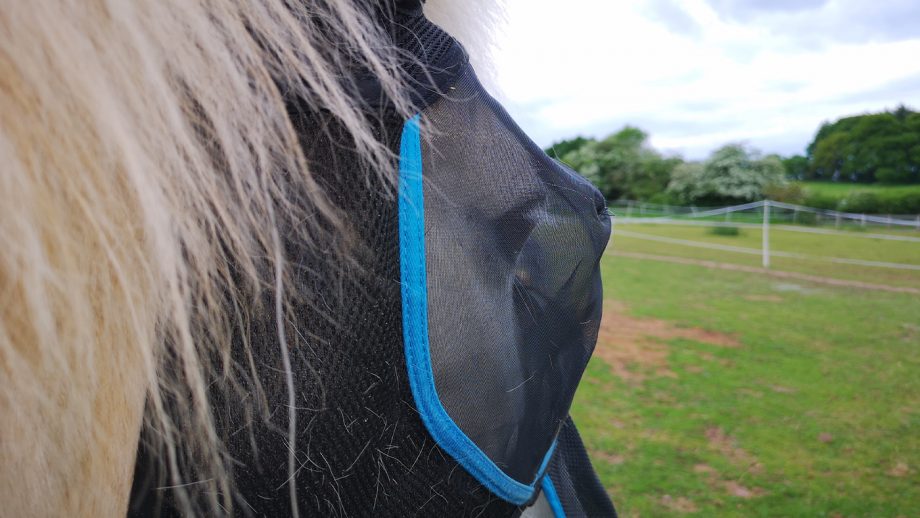From hearing and health issues to how they tell a horse’s feelings, Kieran O’Brien MRCVS delves into the outer ear of the horse
A HORSE has 10 muscles to control ear position and movement, enabling more manoeuvrability than in any other domesticated animal. Each ear is independently mobile and so they can be moved in different directions at the same time.
These adaptations, combined with highly sensitive hearing, allow what was originally a prey animal to be extremely responsive to approaches by other animals that signal threat – and to locate these threats very precisely.
{"content":"PHA+VGhlIGV4dGVybmFsIGVhciwgdGVybWVkIHRoZSBwaW5uYSwgY29tcHJpc2VzIGEgZnVubmVsLXNoYXBlZCB2ZXJ0aWNhbCB0dWJlICh0aGUgdmVydGljYWwgY2FuYWwpLCBtYWRlIG9mIGNhcnRpbGFnZSB3aXRoIG92ZXJseWluZyBza2luLiBUaGlzIGlzIGpvaW5lZCBhdCB0aGUgYmFzZSB2aWEgYSByaWdodC1hbmdsZWQgYmVuZCB0byBhIHNob3J0LCBob3Jpem9udGFsIHR1YmUsIHdoaWNoIGluIHR1cm4gY29ubmVjdHMgdG8gdGhlIGVhcmRydW0uPC9wPgo8cD5BIHRoaW4gY29hdGluZyBvZiB3YXggaXMgcHJvZHVjZWQgYnkgZ2xhbmRzIHRoYXQgbGluZSB0aGUgY2FuYWwuIFRoaXMgd2F4IG5vdCBvbmx5IHNlcnZlcyB0byBrZWVwIHRoZSBlYXIgc3VyZmFjZSBtb2lzdCBhbmQgdG8gdHJhcCBzbWFsbCBwYXJ0aWNsZXMgdGhhdCBtYXkgZW50ZXIgdGhlIGVhciwgYnV0IGFsc28gaGFzIGFudGltaWNyb2JpYWwgYWN0aXZpdHkgYWdhaW5zdCBiYWN0ZXJpYSBhbmQgZnVuZ2kuIEEgbmF0dXJhbCBlYXIgd2F4IOKAnGVzY2FsYXRvcuKAnSwgYXNzaXN0ZWQgYnkgamF3IG1vdmVtZW50LCB0cmFuc3BvcnRzIHRoZSB3YXggYWxvbmcgdGhlIGNhbmFsIHRvIHRoZSBvdXRzaWRlLjwvcD4KPHA+QmVjYXVzZSBhIGhvcnNl4oCZcyBlYXJzIGFyZSB2ZXJ0aWNhbGx5IHBsYWNlZCwgdGhlcmUgaXMgdGhlIHBvdGVudGlhbCBmb3IgcmFpbiBvciBvYmplY3RzIHN1Y2ggYXMgc2VlZHMsIGR1c3QsIHBvbGxlbiBhbmQgaW5zZWN0cyB0byBiZWNvbWUgbG9kZ2VkIGluc2lkZSB0aGVtLiBGb3IgdGhpcyByZWFzb24sIHRoZSBlYXJzIGFyZSBsaW5lZCB3aXRoIGEgZGVuc2UgY29hdGluZyBvZiBpbnRlcmxvY2tpbmcgaGFpcnMgdGhhdCBmaWx0ZXIgb3V0IGV2ZXJ5dGhpbmcgZXhjZXB0IHNvdW5kIHdhdmVzLjwvcD4KPHA+PGRpdiBjbGFzcz0iYWQtY29udGFpbmVyIGFkLWNvbnRhaW5lci0tbW9iaWxlIj48ZGl2IGlkPSJwb3N0LWlubGluZS0yIiBjbGFzcz0iaXBjLWFkdmVydCI+PC9kaXY+PC9kaXY+PHNlY3Rpb24gaWQ9ImVtYmVkX2NvZGUtMzEiIGNsYXNzPSJoaWRkZW4tbWQgaGlkZGVuLWxnIHMtY29udGFpbmVyIHN0aWNreS1hbmNob3IgaGlkZS13aWRnZXQtdGl0bGUgd2lkZ2V0X2VtYmVkX2NvZGUgcHJlbWl1bV9pbmxpbmVfMiI+PHNlY3Rpb24gY2xhc3M9InMtY29udGFpbmVyIGxpc3RpbmctLXNpbmdsZSBsaXN0aW5nLS1zaW5nbGUtc2hhcmV0aHJvdWdoIGltYWdlLWFzcGVjdC1sYW5kc2NhcGUgZGVmYXVsdCBzaGFyZXRocm91Z2gtYWQgc2hhcmV0aHJvdWdoLWFkLWhpZGRlbiI+DQogIDxkaXYgY2xhc3M9InMtY29udGFpbmVyX19pbm5lciI+DQogICAgPHVsPg0KICAgICAgPGxpIGlkPSJuYXRpdmUtY29udGVudC1tb2JpbGUiIGNsYXNzPSJsaXN0aW5nLWl0ZW0iPg0KICAgICAgPC9saT4NCiAgICA8L3VsPg0KICA8L2Rpdj4NCjwvc2VjdGlvbj48L3NlY3Rpb24+PC9wPgo8cD5BY2N1bXVsYXRpb25zIG9mIHdheCBvbiB0aGUgaGFpcnMgYmVsb3cgdGhlIGVhciBjYW4gYmUgc25pcHBlZCBvZmYgd2l0aCBhIHBhaXIgb2Ygc2Npc3NvcnMsIGJ1dCBjbGlwcGluZyBvZiB0aGUgaGFpciBpbnNpZGUgdGhlIGVhciBmb3IgY29zbWV0aWMgcHVycG9zZXMgaXMgc3Ryb25nbHkgZGlzY291cmFnZWQg4oCTIHRoZSBoYWlyIGlzIHRoZXJlIGZvciBhIHZlcnkgZ29vZCByZWFzb24uPC9wPgo8cD5JZiB0aGUgaW5zaWRlIG9mIHRoZSBlYXJzIG11c3QgYmUgd2lwZWQsIG9ubHkgYSBkYW1wIGNsb3RoIHNob3VsZCBiZSB1c2VkIGJlY2F1c2UgbGlxdWlkIHNob3VsZCBub3QgYmUgYWxsb3dlZCB0byBydW4gZG93biBpbnRvIHRoZSBlYXIuPC9wPgo8cD5CZSB2aWdpbGFudCwgaG93ZXZlciwgZm9yIGFueSBzaWduIG9mIGVhciBpcnJpdGF0aW9uIG9yIGRpc2NoYXJnZSwgb3IgYW55IGFibm9ybWFsIGdyb3d0aHMgb24gdGhlIGVhciBzdXJmYWNlLCBib3RoIGV4dGVybmFsbHkgYW5kIGludGVybmFsbHkuPC9wPgo8ZGl2IGNsYXNzPSJhZC1jb250YWluZXIgYWQtY29udGFpbmVyLS1tb2JpbGUiPjxkaXYgaWQ9InBvc3QtaW5saW5lLTMiIGNsYXNzPSJpcGMtYWR2ZXJ0Ij48L2Rpdj48L2Rpdj4KPGgzPldoYXQgY2FuIGEgaG9yc2XigJlzIGVhcnMgdGVsbCB5b3U\/PC9oMz4KPHA+RUFSIHBvc2l0aW9uIG1heSBpbmRpY2F0ZSBwYWluLCBmZWFyLCBjdXJpb3NpdHkgYW5kIGFuZ2VyLiBIb3JzZXMgdXNlIGJvZHkgbGFuZ3VhZ2UgcmF0aGVyIHRoYW4gdm9jYWxpc2F0aW9uIGR1cmluZyB0aGVpciBzb2NpYWwgaW50ZXJhY3Rpb24gd2l0aCBvdGhlciBob3JzZXMsIGFuZCBlYXIgcG9zaXRpb24gaXMgYSBrZXkgaW5kaWNhdG9yIG9mIG1vb2QgZHVyaW5nIHRoZXNlIGludGVyYWN0aW9ucyDigJMgc2lnbmFsbGluZyBhZ2dyZXNzaW9uIG9yIHN1Ym1pc3Npb24uPC9wPgo8cD5BIHN0dWR5IG9mIGZyZWUtcmFuZ2luZyBwb25pZXMgb24gdGhlIElzbGUgb2YgUmh1bSBpbiBTY290bGFuZCBmb3VuZCB0aGF0IDgwJSBvZiBhZ2dyZXNzaXZlIGVuY291bnRlcnMgYmV0d2VlbiBhbmltYWxzIGNvbnNpc3RlZCBvZiB0aHJlYXRzIHdpdGggdGhlIGhlYWQgYWxvbmUsIGJ5IHBpbm5pbmcgdGhlIGVhcnMgYmFjayBhbmQgZXh0ZW5kaW5nIHRoZSBuZWNrLiBJdCBpcyBhbHNvIGFzc3VtZWQgdGhhdCB3aGVuIGhvcnNlcyBmaWdodCwgdGhlIGVhcnMgYXJlIGhlbGQgcGlubmVkIGJhY2sgdG8gcHJvdGVjdCB0aGVtIGZyb20gaW5qdXJ5LjwvcD4KPGRpdiBjbGFzcz0iYWQtY29udGFpbmVyIGFkLWNvbnRhaW5lci0tbW9iaWxlIj48ZGl2IGlkPSJwb3N0LWlubGluZS00IiBjbGFzcz0iaXBjLWFkdmVydCI+PC9kaXY+PC9kaXY+CjxwPlJlY2VudCBzdHVkaWVzIGxvb2tlZCBhdCB0aGUgPGEgaHJlZj0iaHR0cHM6Ly93d3cuaG9yc2VhbmRob3VuZC5jby51ay9wbHVzL2ZhY2lhbC1leHByZXNzaW9ucy1zaG93LXBhaW4taG9yc2VzLTYyODcwMyI+ZmFjaWFsIGV4cHJlc3Npb25zPC9hPiwgaW5jbHVkaW5nIGVhciBwb3NpdGlvbiwgb2YgbGFtZSBhbmQgbm9uLWxhbWUgaG9yc2VzIHdoZW4gYmVpbmcgcmlkZGVuLiBJdCB3YXMgZm91bmQgdGhhdCB0aGUgZWFycyB3ZXJlIGJlaGluZCB0aGUgdmVydGljYWwgaW4gNDMlIG9mIG5vbi1sYW1lLCBidXQgaW4gNzclIG9mIGxhbWUgaG9yc2VzLiBXZSBhcmUgb25seSBub3cgYmVnaW5uaW5nIHRvIHVuZGVyc3RhbmQgaG93IGhvcnNlcyBzaWduYWwgdGhlaXIg4oCcd2VsbG5lc3PigJ0gdmlhIHRoZWlyIGZhY2lhbCBleHByZXNzaW9ucy4gRWFyIHBvc2l0aW9uIG1heSBiZSBhIGtleSBlbGVtZW50IGluIHRoaXMuPC9wPgo8cD5UaGUgZHJvb3Bpbmcgb2Ygb25lIGVhciB0byB0aGUgc2lkZSBhbmQgbG9zcyBvZiBtb3RvciBjb250cm9sIG1heSBpbmRpY2F0ZSBwYXJhbHlzaXMgb2YgdGhlIG5lcnZlcyBjb250cm9sbGluZyB0aGUgZWFyIG11c2NsZXMuIFRoaXMgY2FuIG9jY3VyIGR1ZSB0byBkYW1hZ2UgdG8gdGhlIGZhY2lhbCBuZXJ2ZSwgaW5mZWN0aW9uIGluIHRoZSBndXR0dXJhbCBwb3VjaCBvciBpbm5lciBlYXIsIGFuZCBhcnRocml0aXMgb2YgdGhlIGpvaW50IGJldHdlZW4gdGhlIGh5b2lkIGJvbmVzICh0aGF0IHNpdCBiZXR3ZWVuIHRoZSB0d28gaGFsdmVzIG9mIHRoZSBsb3dlciBqYXcpIGFuZCB0aGUgc2t1bGwuPC9wPgo8ZGl2IGNsYXNzPSJhZC1jb250YWluZXIgYWQtY29udGFpbmVyLS1tb2JpbGUiPjxkaXYgaWQ9InBvc3QtaW5saW5lLTUiIGNsYXNzPSJpcGMtYWR2ZXJ0Ij48L2Rpdj48L2Rpdj4KPGgzPkNvbW1vbiBlYXIgcHJvYmxlbXMgaW4gaG9yc2VzPC9oMz4KPHA+QU5ZIGlycml0YXRpb24gaW4gdGhlIGVhcnMgY2FuIGNhdXNlIGEgaG9yc2UgdG8gc2hha2UgaGlzIGhlYWQuIEFsdGhvdWdoIDxhIGhyZWY9Imh0dHBzOi8vd3d3LmhvcnNlYW5kaG91bmQuY28udWsvaG9yc2UtY2FyZS92ZXQtYWR2aWNlL2hlYWRzaGFraW5nLWluLWhvcnNlcy04OTM4NiI+aGVhZHNoYWtpbmc8L2E+IGJlaGF2aW91ciBpcyBvZnRlbiBhdHRyaWJ1dGVkIHRvIGVhciBtaXRlcywgdGhlIHByZXZhbGVuY2Ugb2YgdGhlc2UgaW4gdGhlIFVLIGlzIG5vdyBsb3cuPC9wPgo8cD5XaGVyZSBwcmVzZW50LCB0aGUgbWl0ZXMgY2F1c2UgaXJyaXRhdGlvbiwgZWFyIHJ1YmJpbmcgYW5kIHNoYWtpbmcgb2YgdGhlIGhlYWQgaW4gcmFuZG9tIGRpcmVjdGlvbnMuIFRoaXMgY29udHJhc3RzIHdpdGggdGhlIHRydWUgZXF1aW5lIGhlYWRzaGFraW5nIHN5bmRyb21lLCB3aGVyZSB0aGVyZSBpcyBubyBlYXIgcnViYmluZywgdGhlIOKAnHNoYWtpbmfigJ0gYWN0aW9uIGlzIGFsbW9zdCBzb2xlbHkgYSB2ZXJ0aWNhbCDigJxmbGlw4oCdIG9mIHRoZSBoZWFkIChtYWlubHkgd2hlbiByaWRkZW4pIGFuZCB0aGUgaXJyaXRhdGlvbiBvY2N1cnMgaW4gdGhlIG5vc2UsIG5vdCB0aGUgZWFycy48L3A+CjxwPkJ1dCB0aGUgZmFjZSBhbmQgZWFycyBhcmUgY29tbW9uIGJpdGluZyBzaXRlcyBmb3IgbWlkZ2VzLiBBbiBhbGxlcmdpYyByZXNwb25zZSB0byB0aGVpciBzYWxpdmEgaXMgdHJpZ2dlcmVkIGluIGhvcnNlcyBzdWZmZXJpbmcgZnJvbSA8YSBocmVmPSJodHRwczovL3d3dy5ob3JzZWFuZGhvdW5kLmNvLnVrL3BsdXMvdmV0LWxpYnJhcnkvc3dlZXQtaXRjaC1pbi1ob3JzZXMtNDcxOTIzIj5zd2VldCBpdGNoPC9hPi4gSW4gYWR2YW5jZWQgY2FzZXMsIHNlbGYtdHJhdW1hIHdpbGwgcmVzdWx0IGFzIHRoZSBob3JzZSB0cmllcyB0byByZWxpZXZlIHRoZSBpcnJpdGF0aW9uIGNhdXNlZCBieSBoaXN0YW1pbmUgcmVsZWFzZSBpbiB0aGUgc2tpbi4gVGhlIHNraW4gY2FuIGJlIHJ1YmJlZCBhbG1vc3QgcmF3LCB3aGljaCBjYW4gY2F1c2UgYmxlZWRpbmcgc29yZXMsIHNvIHByb3RlY3QgdGhpcyByZWdpb24gd2l0aCBhIDxhIGhyZWY9Imh0dHBzOi8vd3d3LmhvcnNlYW5kaG91bmQuY28udWsvYnV5ZXJzLWd1aWRlcy9mb3JnZXQtZmxpZXMtd2l0aC10aGVzZS0xMi1mbHktbWFza3MtNTQ0Mjk5Ij5maW5lLW1lc2hlZCBmYWNlIG1hc2s8L2E+IHRoYXQgY292ZXJzIHRoZSBlYXJzLjwvcD4KPHA+QmxhY2tmbGllcyBjYW4gYXR0YWNrIHRoZSBza2luIG9uIHRoZSBpbnNpZGUgb2YgdGhlIGhvcnNl4oCZcyBlYXJzIGFuZCBpbiB0aGUgbWlkbGluZSwgaW4gZnJvbnQgb2YgdGhlIHVkZGVyIG9yIHNoZWF0aC4gVGhleSBzdWNrIGJsb29kIGFuZCBpbiBkb2luZyBzbywgY2FuIHNwcmVhZCBhIHBhcGlsbG9tYSB2aXJ1cyB0aGF0IGNhdXNlcyBmbGF0LCBzY2FseSBhbmQgaW5pdGlhbGx5IGNpcmN1bGFyIHdoaXRlLWdyZXkgem9uZXMgaW4gdGhlIGVhcnMuPC9wPgo8cD5Tb21ldGltZXMsIHRoZXNlIHdhcnR5IOKAnDxhIGhyZWY9Imh0dHBzOi8vd3d3LmhvcnNlYW5kaG91bmQuY28udWsvaG9yc2UtY2FyZS92ZXQtYWR2aWNlL3doYXQtYXJlLWF1cmFsLXBsYXF1ZXMtMTEwMTc1Ij5hdXJhbCBwbGFxdWVzPC9hPuKAnSBwcm9saWZlcmF0ZSBhbmQgcHJvdHJ1ZGUgZnJvbSB0aGUgc2tpbi4gU29tZSByZWdyZXNzIHNwb250YW5lb3VzbHksIGJ1dCBvdGhlcnMgcGVyc2lzdCBmb3IgbGlmZS4gVGhleSBhcmUgcmFyZWx5IHRyZWF0ZWQgYXMgdGhleSBkbyBub3QgY2F1c2UgYSBjbGluaWNhbCBwcm9ibGVtLCBhbmQgYW55IHRyZWF0bWVudCB3aWxsIHVzdWFsbHkgcmVzdWx0IGluIGEgaGVhZC1zaHkgaG9yc2UuPC9wPgo8cD5UaG91Z2h0IHRvIGJlIGNhdXNlZCBieSBhIGNhdHRsZSB3YXJ0IHZpcnVzLCBwcm9iYWJseSBzcHJlYWQgYnkgZmxpZXMsIDxhIGhyZWY9Imh0dHBzOi8vd3d3LmhvcnNlYW5kaG91bmQuY28udWsvaG9yc2UtY2FyZS92ZXQtYWR2aWNlL3NhcmNvaWRzLWluLWhvcnNlcy02MDE0MzQiPnNhcmNvaWRzPC9hPiBjYW4gZGV2ZWxvcCBhbnl3aGVyZSBvbiBhIGhvcnNl4oCZcyBib2R5LCBpbmNsdWRpbmcgb2NjYXNpb25hbGx5IG9uIHRoZSBlYXJzLiBUaGV5IG1heSBsb29rIGxpa2UgYW4gYXJlYSBvZiBoYWlybGVzcywgc2NhbHkgc2tpbiBvciBhcHBlYXIgYXMgZ3Jvd3RocyB0aGF0IGVubGFyZ2Ugb3ZlciB0aW1lLiA8YSBocmVmPSJodHRwczovL3d3dy5ob3JzZWFuZGhvdW5kLmNvLnVrL3BsdXMvdmV0LWxpYnJhcnkvbWVsYW5vbWFzLWhvcnNlcy1lcXVpbmUtbWFsaWduYW50LW1lbGFub21hcy03MDQwNjQiPk1lbGFub21hczwvYT4gYW5kIDxhIGhyZWY9Imh0dHBzOi8vd3d3LmhvcnNlYW5kaG91bmQuY28udWsvZmVhdHVyZXMvY2FuY2VyLWluLWhvcnNlcy01ODA3OCI+c3F1YW1vdXMgY2VsbCBjYXJjaW5vbWFzPC9hPiBjYW4gYWxzbyBvY2N1ciBpbiB0aGUgZWFyIGFyZWEuPC9wPgo8cD5UaGVzZSB0dW1vdXJzIG11c3QgYmUgdHJlYXRlZCBlYXJseSB3aGVuIHNtYWxsLCB0byBlbnN1cmUgdGhlIHRyZWF0bWVudCBpcyBlZmZlY3RpdmUgYW5kIHRoZSBob3JzZSBkb2VzIG5vdCBiZWNvbWUgaGVhZC1zaHkgYXMgYSByZXN1bHQuIFRvcGljYWwgY2hlbW90aGVyYXB5IG1heSBiZSBzdWNjZXNzZnVsLCBidXQgc29tZSBncm93dGhzIHJlcXVpcmUgcmVtb3ZhbDsgYSBzdXJnaWNhbCBsYXNlciBpcyBvZnRlbiB1c2VkIG9uIHNhcmNvaWRzIGFuZCB0dW1vdXJzLCBidXQgdGhpcyBjYW4gYmUgaGF6YXJkb3VzIGluIHRoZSBlYXIgcmVnaW9uIGR1ZSB0byB0aGUgcmlzayBvZiBkYW1hZ2UgdG8gdGhlIGNhcnRpbGFnZSB1bmRlcmx5aW5nIHRoZSBza2luLjwvcD4KPHA+QSByYXJlIG9jY3VycmVuY2UgYXQgYSB5b3VuZyBhZ2UgaXMgYW4gb3BlbmluZyBvbiB0aGUgZnJvbnQgbWFyZ2luIG9mIHRoZSBlYXIgZmxhcCB0aGF0IG9vemVzIGEgc3RpY2t5IGZsdWlkLiBDYWxsZWQgYSBkZW50aWdlcm91cyBjeXN0LCB0aGlzIGNvbW11bmljYXRlcyB3aXRoIGFuIGFibm9ybWFsIGFyZWEgb2YgZGVudGFsIHRpc3N1ZSDigJMgc29tZXRpbWVzIGFuIGVudGlyZSB0b290aCDigJMgdXN1YWxseSBjbG9zZSBieSBpbiB0aGUgaGVhZC4gVGhpcyBkZXZlbG9wbWVudGFsIGFibm9ybWFsaXR5IHJhcmVseSBjYXVzZXMgYW55IG90aGVyIHN5bXB0b21zIGFuZCB1c3VhbGx5IGNhbiBiZSBzYWZlbHkgbGVmdCB1bnRyZWF0ZWQuPC9wPgo8aDM+V2h5IGVhcnMgbXVzdCBiZSBoYW5kbGVkIHdpdGggY2FyZTwvaDM+CjxwPkhFQUQtU0hZIGhvcnNlcyBhcmUgY29tbW9ubHkgZW5jb3VudGVyZWQgaW4gdmV0ZXJpbmFyeSB3b3JrLiBXaGlsZSBzb21lIGFuaW1hbHMgd2lsbCBhY2NlcHQgdGhlaXIgZWFycyBiZWluZyBoYW5kbGVkLCBvdGhlcnMgaW5zdGluY3RpdmVseSByZXNlbnQgdGhlIHRvdWNoLiBUaGVzZSBob3JzZXMgbXVzdCBiZSBkZXNlbnNpdGlzZWQgYnkgY2FyZWZ1bCBhbmQgc2tpbGZ1bCByZXBldGl0aW9uLCB1c2luZyBiZWhhdmlvdXJhbCB0ZWNobmlxdWVzIGZyb20gYSB5b3VuZyBhZ2UuPC9wPgo8cD5BbnkgdmV0ZXJpbmFyeSBwcm9jZWR1cmUgaW52b2x2aW5nIHRoZSBhcHBsaWNhdGlvbiBvZiBjcmVhbXMgYW5kIG90aGVyIHRyZWF0bWVudHMgdG8gdGhlIGVhcnMgbXVzdCBub3QgYmUgZW1iYXJrZWQgdXBvbiBsaWdodGx5LCBiZWNhdXNlIGV2ZW4gd2l0aCB0aGUgZ3JlYXRlc3QgY2FyZSwgaGVhZC1zaHluZXNzIGNhbiByZXN1bHQuPC9wPgo8ZGl2IGNsYXNzPSJpbmplY3Rpb24iPjwvZGl2Pgo8cD5BcHBseWluZyBhIHR3aXRjaCAoYSByZXN0cmFpbmluZyBkZXZpY2UpIHRvIHRoZSBlYXIgaXMgc3Ryb25nbHkgZGlzY291cmFnZWQuIEEgc3R1ZHkgZm91bmQgdGhhdCB3aGlsZSBhIHR3aXRjaCBhcHBsaWVkIHRvIHRoZSB1cHBlciBsaXAgbG93ZXJzIHRoZSBoZWFydCByYXRlIGFuZCBpcyBjYWxtaW5nLCBhbiBlYXIgdHdpdGNoIGNhdXNlcyBhIHJpc2UgaW4gaGVhcnQgcmF0ZSBhbmQgYmxvb2QgY29ydGlzb2wgbGV2ZWwg4oCTIGluZGljYXRpbmcgdGhlIGhvcnNlIGlzIGluIHBhaW4uPC9wPgo8cD4K"}
.
This Vet Clinic feature was first published in 15 July issue of Horse & Hound magazine
You may also be interested in…
The clue is in the name — horseflies seek out their target and cause havoc with their vicious biting mouthparts.
Credit: Peter Nixon
When a badly inflamed ear canal failed to settle, a carriage horse required radical surgery. Gil Riley MRCVS explains
PAPILLOMATOSIS
An eruption of lumps can spoil the good looks of any youngster, but the effects are usually short-lived, as Karen
Credit: Professor Derek Knottenbelt





